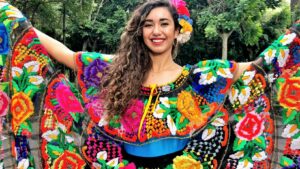 In the vibrant tapestry of Mexican culture, the traditional wedding dress stands out as a symbol of rich heritage and timeless elegance. These dresses, often adorned with intricate embroidery and vivid colors, tell stories of generations past while celebrating the beauty of cultural diversity. Rooted in indigenous and Spanish influences, the old traditional Mexican wedding dress reflects a unique blend of history and artistry. For many brides, wearing these exquisite garments is more than just a fashion choice; it’s a tribute to their ancestry and a connection to their roots. Each dress, meticulously crafted with love and care, showcases a variety of regional styles and techniques. From the flowing skirts to the detailed bodices, these dresses capture the essence of Mexico’s vibrant spirit and enduring traditions.
In the vibrant tapestry of Mexican culture, the traditional wedding dress stands out as a symbol of rich heritage and timeless elegance. These dresses, often adorned with intricate embroidery and vivid colors, tell stories of generations past while celebrating the beauty of cultural diversity. Rooted in indigenous and Spanish influences, the old traditional Mexican wedding dress reflects a unique blend of history and artistry. For many brides, wearing these exquisite garments is more than just a fashion choice; it’s a tribute to their ancestry and a connection to their roots. Each dress, meticulously crafted with love and care, showcases a variety of regional styles and techniques. From the flowing skirts to the detailed bodices, these dresses capture the essence of Mexico’s vibrant spirit and enduring traditions.
Old Traditional Mexican Wedding Dress
 Old traditional Mexican wedding dresses exhibit a unique blend of cultural artistry and craftsmanship. Typically made of cotton or satin, these dresses often feature hand-embroidered floral patterns and intricate lace details. The use of vibrant reds, blues, and greens signifies prosperity and joy. Distinct styles vary across regions. In Oaxaca, dresses with Zapotec motifs display indigenous design heritage. The Jalisco region presents blouses and skirts adorned with colorful ribbons and patterns. These elements represent the fusion of indigenous and Spanish influences.
Old traditional Mexican wedding dresses exhibit a unique blend of cultural artistry and craftsmanship. Typically made of cotton or satin, these dresses often feature hand-embroidered floral patterns and intricate lace details. The use of vibrant reds, blues, and greens signifies prosperity and joy. Distinct styles vary across regions. In Oaxaca, dresses with Zapotec motifs display indigenous design heritage. The Jalisco region presents blouses and skirts adorned with colorful ribbons and patterns. These elements represent the fusion of indigenous and Spanish influences.
Traditional Elements of the Dress
Old traditional Mexican wedding dresses are known for their rich cultural symbolism and exquisite craftsmanship. The dresses capture the essence of Mexican heritage, showing the artistry and cultural depth through their design features.
Fabrics and Materials Used
Traditional Mexican wedding dresses often use natural materials. Cotton and satin are among the most common fabrics, valued for their comfort and elegance. Cotton provides breathability, ideal for the warm climates in many Mexican regions. Satin, noted for its sheen, is used to lend an air of sophistication. More elaborate dresses might incorporate lace, enhancing their decorative appeal. Natural dyes are frequently used, resulting in vibrant fabrics that reflect the region’s natural beauty.
Embroidery and Patterns
Intricate embroidery distinguishes these dresses, with designs often rooted in indigenous and colonial traditions. Floral patterns are prevalent, symbolizing fertility and growth. Motifs frequently include roses, daisies, and marigolds, embodying prosperity and joy. Regional patterns add diversity; for instance, Oaxaca is known for its geometric Zapotec designs while Jalisco incorporates bold, colorful ribbons. Skillful hand embroidery showcases artisanal expertise and invested labor, creating dresses that are both unique and culturally significant.
Cultural Significance and Symbolism
Traditional Mexican wedding dresses hold deep cultural significance. They convey rich symbolism in every detail, from colors to accessories, serving as a bridge between heritage and modernity.
Colors and Their Meanings
 Colors in Mexican wedding dresses are more than decorative; they carry meaningful symbolism. Vibrant hues represent key cultural themes. Red often signifies love and passion, while blue conveys tranquility and fidelity. Green symbolizes prosperity and new beginnings, echoing hopes for a prosperous marriage. These colors, often intertwined with floral motifs, enhance the dress’s narrative, connecting them to Mexican cultural traditions.
Colors in Mexican wedding dresses are more than decorative; they carry meaningful symbolism. Vibrant hues represent key cultural themes. Red often signifies love and passion, while blue conveys tranquility and fidelity. Green symbolizes prosperity and new beginnings, echoing hopes for a prosperous marriage. These colors, often intertwined with floral motifs, enhance the dress’s narrative, connecting them to Mexican cultural traditions.
Accessories and Their Roles
Accessories enhance the cultural symbolism of the dress. The rebozo, a traditional shawl, embodies warmth and protection, often passed down through generations. Mantillas, lace veils, link the bride to Spanish colonial influences and confer a sense of elegance. Huipiles, embroidered tunics worn by indigenous women, connect to ancient traditions and emphasize regional identity. These accessories add depth to the ensemble, reinforcing the cultural narrative embodied by the wedding attire.
Evolution Over Time
Old traditional Mexican wedding dresses continue to captivate with their rich history and cultural depth. As time progresses these garments remain a testament to the enduring allure of Mexican heritage and artistry. Brides today embrace these dresses not only for their beauty but also for the profound connection they offer to their roots. The evolution of these dresses showcases a seamless blend of tradition and modernity where each stitch tells a story of cultural pride and timeless elegance. Celebrating the past while looking to the future these dresses stand as a vibrant symbol of identity and unity.



